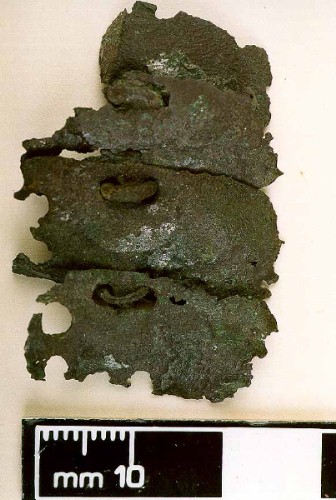|
|
Fragment of Scale Armour from Alchester: 1st century |

The four plates of sheet bronze scale armour held in an overlapping position by bronze links in side perforations, are all that remains of a Roman suit of armour found just outside the north gate of the Roman town at Alchester. It would have been worn by a Roman soldier, and the surface seems to have been tinned in imitation of silver.
The town of Alchester lies at the junction of two important Roman routes: Akeman Street, the east-west route between Verulamium and Cirencester; and the north-south route from Towcester on Watling Street to Silchester passing through Dorchester-on-Thames. Both roads must have been established at, or shortly after, the Conquest of Britain in AD 43, and the town, presumably based on a fort, to judge from military finds made there, some time in the 1st century. A Roman fortress and parade ground, the fortress dating to the very early years of the Roman conquest in the 40s, has recently been discovered at Alchester.
A tombstone of the Thracian horseman Longinus in the Colchester Museum shows this soldier weaaring just such a suit of armour, and dates from the 40s. Scale armour was worn by both types of Roman soldier - "legionaries" and "auxiliaries" - and by both foot-soldiers and cavalry - in other words by many of the commissioned officers in the Roman army.
© 1998 Oxfordshire Museum Service, Setúbal Museums and the Benaki Museum